
cluster-toolkit
Cluster Toolkit is an open-source software offered by Google Cloud which makes it easy for customers to deploy AI/ML and HPC environments on Google Cloud.
Stars: 285
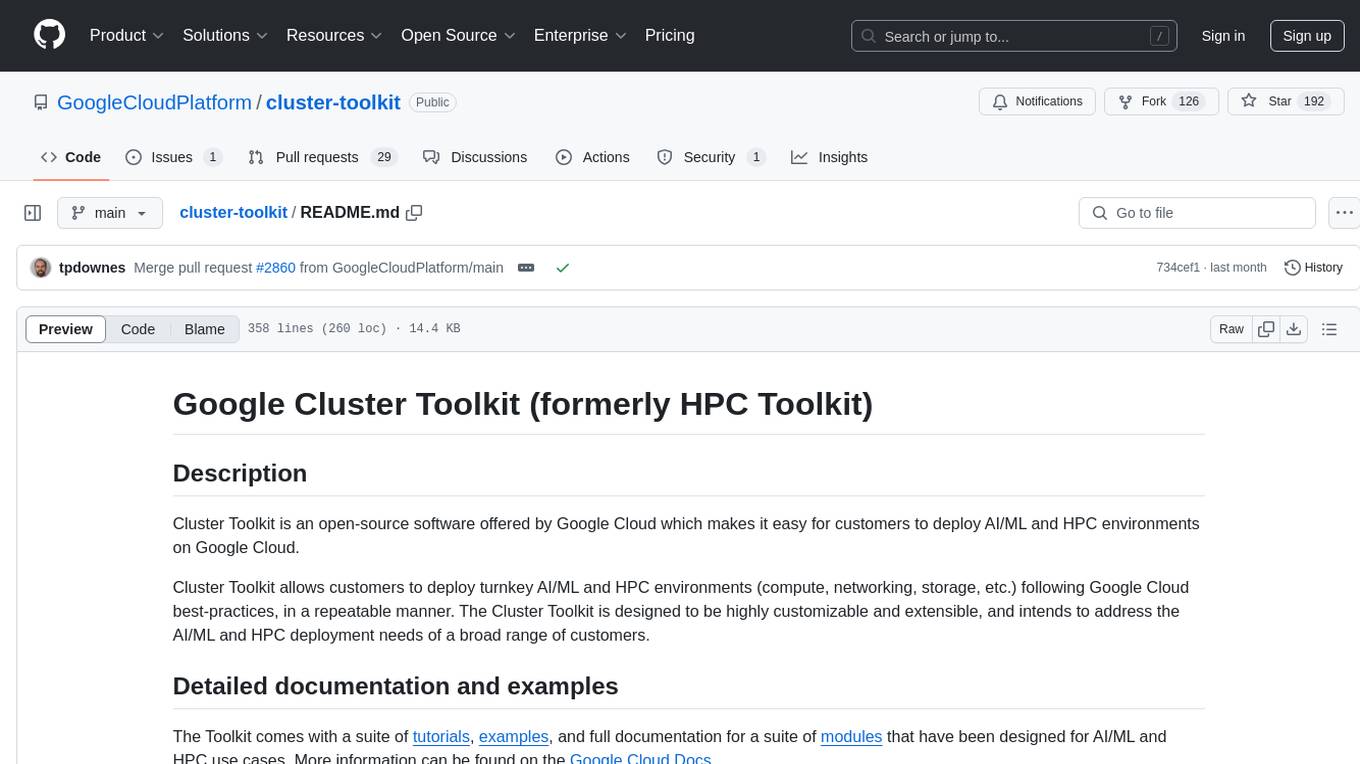
Cluster Toolkit is an open-source software by Google Cloud for deploying AI/ML and HPC environments on Google Cloud. It allows easy deployment following best practices, with high customization and extensibility. The toolkit includes tutorials, examples, and documentation for various modules designed for AI/ML and HPC use cases.
README:
Cluster Toolkit is an open-source software offered by Google Cloud which makes it easy for customers to deploy AI/ML and HPC environments on Google Cloud.
Cluster Toolkit allows customers to deploy turnkey AI/ML and HPC environments (compute, networking, storage, etc.) following Google Cloud best-practices, in a repeatable manner. The Cluster Toolkit is designed to be highly customizable and extensible, and intends to address the AI/ML and HPC deployment needs of a broad range of customers.
The Cluster Toolkit is an integral part of Google Cloud AI Hypercomputer. Documentation concerning AI Hypercomputer solutions is available for GKE and for Slurm.
The Toolkit provides tutorials, examples, and comprehensive developer documentation for a suite of modules that have been designed for AI/ML and HPC use cases.
For end-user guides and how-to information, please refer to the Google Cloud Docs.
Running through the quickstart tutorial is the recommended path to get started with the Cluster Toolkit.
If a self directed path is preferred, you can use the following commands to
build the gcluster binary:
git clone https://github.com/GoogleCloudPlatform/cluster-toolkit
cd cluster-toolkit
make
./gcluster --version
./gcluster --helpNOTE: You may need to install dependencies first.
Learn about the components that make up the Cluster Toolkit and more on how it works on the Google Cloud Docs Product Overview.
Terraform can discover credentials for authenticating to Google Cloud Platform in several ways. We will summarize Terraform's documentation for using gcloud from your workstation and for automatically finding credentials in cloud environments. We do not recommend following Hashicorp's instructions for downloading service account keys.
You can generate cloud credentials associated with your Google Cloud account using the following command:
gcloud auth application-default loginYou will be prompted to open your web browser and authenticate to Google Cloud and make your account accessible from the command-line. Once this command completes, Terraform will automatically use your "Application Default Credentials."
If you receive failure messages containing "quota project" you should change the quota project associated with your Application Default Credentials with the following command and provide your current project ID as the argument:
gcloud auth application-default set-quota-project ${PROJECT-ID}In virtualized settings, the cloud credentials of accounts can be attached directly to the execution environment. For example: a VM or a container can have service accounts attached to them. The Google Cloud Shell is an interactive command line environment which inherits the credentials of the user logged in to the Google Cloud Console.
Many of the above examples are easily executed within a Cloud Shell environment. Be aware that Cloud Shell has several limitations, in particular an inactivity timeout that will close running shells after 20 minutes. Please consider it only for blueprints that are quickly deployed.
The Cluster Toolkit officially supports the following VM images:
- HPC Rocky Linux 8
- Debian 11
- Ubuntu 20.04 LTS
For more information on these and other images, see docs/vm-images.md.
Warning: Slurm Terraform modules cannot be directly used on the standard OS images. They must be used in combination with images built for the versioned release of the Terraform module.
The Cluster Toolkit provides modules and examples for implementing pre-built and custom Slurm VM images, see Slurm on GCP
The Toolkit contains "validator" functions that perform basic tests of the blueprint to ensure that deployment variables are valid and that the AI/ML and HPC environment can be provisioned in your Google Cloud project. Further information can be found in dedicated documentation.
In a new GCP project there are several APIs that must be enabled to deploy your
cluster. These will be caught when you perform terraform apply but you can
save time by enabling them upfront.
See Google Cloud Docs for instructions.
You may need to request additional quota to be able to deploy and use your cluster.
See Google Cloud Docs for more information.
You can view your billing reports for your cluster on the
Cloud Billing Reports
page. To view the Cloud Billing reports for your Cloud Billing account,
including viewing the cost information for all of the Cloud projects that are
linked to the account, you need a role that includes the
billing.accounts.getSpendingInformation permission on your Cloud Billing
account.
To view the Cloud Billing reports for your Cloud Billing account:
- In the Google Cloud Console, go to
Navigation Menu>Billing. - At the prompt, choose the Cloud Billing account for which you'd like to view reports. The Billing Overview page opens for the selected billing account.
- In the Billing navigation menu, select
Reports.
In the right side, expand the Filters view and then filter by label, specifying the key ghpc_deployment (or ghpc_blueprint) and the desired value.
Confirm that you have properly setup Google Cloud credentials
Please see the dedicated troubleshooting guide for Slurm.
When terraform apply fails, Terraform generally provides a useful error
message. Here are some common reasons for the deployment to fail:
-
GCP Access: The credentials being used to call
terraform applydo not have access to the GCP project. This can be fixed by granting access inIAM & Admin. - Disabled APIs: The GCP project must have the proper APIs enabled. See Enable GCP APIs.
- Insufficient Quota: The GCP project does not have enough quota to provision the requested resources. See GCP Quotas.
-
Filestore resource limit: When regularly deploying Filestore instances
with a new VPC you may see an error during deployment such as:
System limit for internal resources has been reached. See this doc for the solution. -
Required permission not found:
- Example:
Required 'compute.projects.get' permission for 'projects/... forbidden - Credentials may not be set, or are not set correctly. Please follow instructions at Cloud credentials on your workstation.
- Ensure proper permissions are set in the cloud console IAM section.
- Example:
If terraform destroy fails with an error such as the following:
│ Error: Error when reading or editing Subnetwork: googleapi: Error 400: The subnetwork resource 'projects/<project_name>/regions/<region>/subnetworks/<subnetwork_name>' is already being used by 'projects/<project_name>/zones/<zone>/instances/<instance_name>', resourceInUseByAnotherResource
or
│ Error: Error waiting for Deleting Network: The network resource 'projects/<project_name>/global/networks/<vpc_network_name>' is already being used by 'projects/<project_name>/global/firewalls/<firewall_rule_name>'
These errors indicate that the VPC network cannot be destroyed because resources were added outside of Terraform and that those resources depend upon the network. These resources should be deleted manually. The first message indicates that a new VM has been added to a subnetwork within the VPC network. The second message indicates that a new firewall rule has been added to the VPC network. If your error message does not look like these, examine it carefully to identify the type of resource to delete and its unique name. In the two messages above, the resource names appear toward the end of the error message. The following links will take you directly to the areas within the Cloud Console for managing VMs and Firewall rules. Make certain that your project ID is selected in the drop-down menu at the top-left.
The deployment will be created with the following directory structure:
<<OUTPUT_PATH>>/<<DEPLOYMENT_NAME>>/{<<DEPLOYMENT_GROUPS>>}/
If an output directory is provided with the --output/-o flag, the deployment
directory will be created in the output directory, represented as
<<OUTPUT_PATH>> here. If not provided, <<OUTPUT_PATH>> will default to the
current working directory.
The deployment directory is created in <<OUTPUT_PATH>> as a directory matching
the provided deployment_name deployment variable (vars) in the blueprint.
Within the deployment directory are directories representing each deployment
group in the blueprint named the same as the group field for each element
in deployment_groups.
In each deployment group directory, are all of the configuration scripts and
modules needed to deploy. The modules are in a directory named modules named
the same as the source module, for example the
vpc module is in a directory named vpc.
A hidden directory containing meta information and backups is also created and
named .ghpc.
From the hpc-slurm.yaml example, we get the following deployment directory:
hpc-slurm/
primary/
main.tf
modules/
providers.tf
terraform.tfvars
variables.tf
versions.tf
.ghpc/
See Cloud Docs on Installing Dependencies.
The Toolkit supports Packer templates in the contemporary HCL2 file format and not in the legacy JSON file format. We require the use of Packer 1.7.9 or above, and recommend using the latest release.
The Toolkit's Packer template module documentation describes input variables and their behavior. An image-building example and usage instructions are provided. The example integrates Packer, Terraform and startup-script runners to demonstrate the power of customizing images using the same scripts that can be applied at boot-time.
The following setup is in addition to the dependencies needed to build and run Cluster-Toolkit.
Please use the pre-commit hooks configured in
this repository to ensure that all changes are validated, tested and properly
documented before pushing code changes. The pre-commits configured
in the Cluster Toolkit have a set of dependencies that need to be installed before
successfully passing.
Follow these steps to install and setup pre-commit in your cloned repository:
-
Install pre-commit using the instructions from the pre-commit website.
-
Install TFLint using the instructions from the TFLint documentation.
NOTE: The version of TFLint must be compatible with the Google plugin version identified in tflint.hcl. Versions of the plugin
>=0.20.0should usetflint>=0.40.0. These versions are readily available via GitHub or package managers. Please review the TFLint Ruleset for Google Release Notes for up-to-date requirements.
-
Install ShellCheck using the instructions from the ShellCheck documentation
-
The other dev dependencies can be installed by running the following command in the project root directory:
make install-dev-deps
-
Pre-commit is enabled on a repo-by-repo basis by running the following command in the project root directory:
pre-commit install
Now pre-commit is configured to automatically run before you commit.
While macOS is a supported environment for building and executing the Toolkit, it is not supported for Toolkit development due to GNU specific shell scripts.
If developing on a mac, a workaround is to install GNU tooling by installing
coreutils and findutils from a package manager such as homebrew or conda.
Please refer to the contributing file in our GitHub repository, or to Google’s Open Source documentation.
For Tasks:
Click tags to check more tools for each tasksFor Jobs:
Alternative AI tools for cluster-toolkit
Similar Open Source Tools

cluster-toolkit
Cluster Toolkit is an open-source software by Google Cloud for deploying AI/ML and HPC environments on Google Cloud. It allows easy deployment following best practices, with high customization and extensibility. The toolkit includes tutorials, examples, and documentation for various modules designed for AI/ML and HPC use cases.
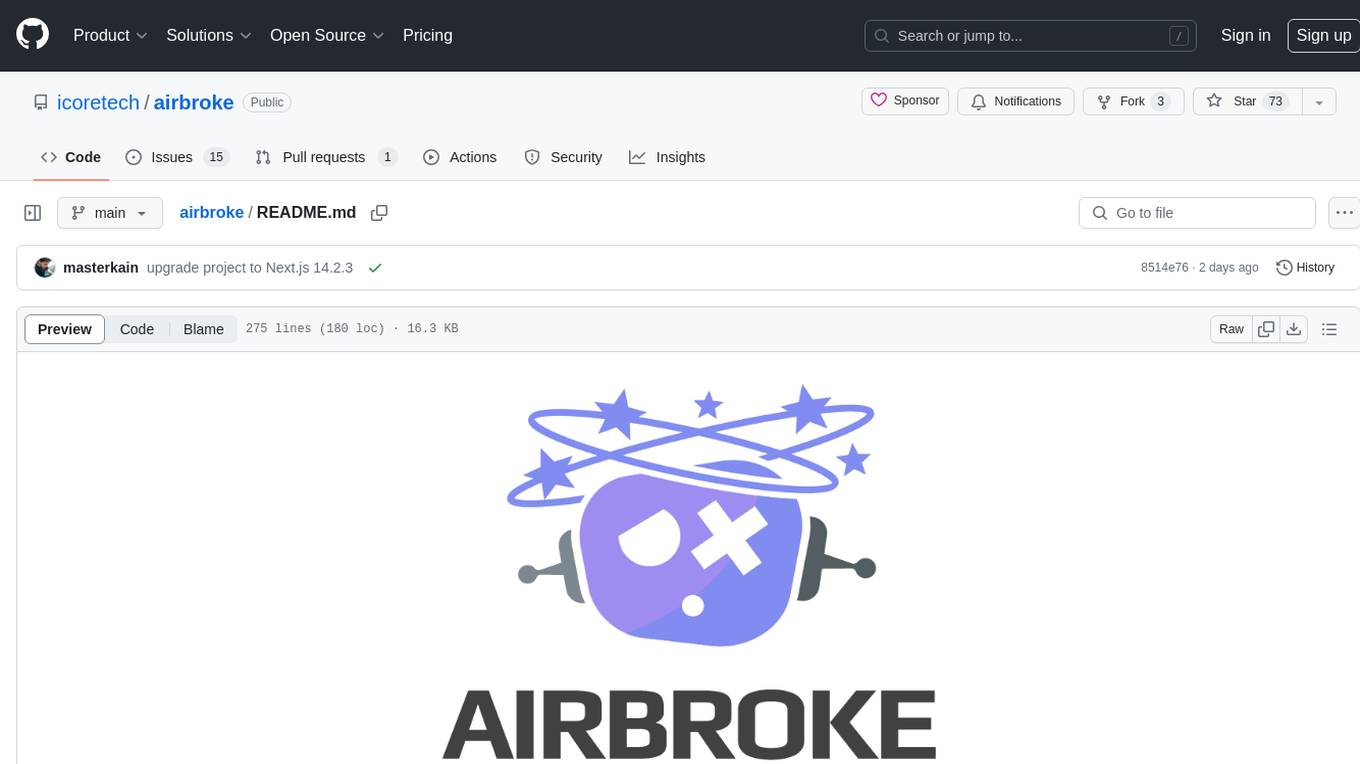
airbroke
Airbroke is an open-source error catcher tool designed for modern web applications. It provides a PostgreSQL-based backend with an Airbrake-compatible HTTP collector endpoint and a React-based frontend for error management. The tool focuses on simplicity, maintaining a small database footprint even under heavy data ingestion. Users can ask AI about issues, replay HTTP exceptions, and save/manage bookmarks for important occurrences. Airbroke supports multiple OAuth providers for secure user authentication and offers occurrence charts for better insights into error occurrences. The tool can be deployed in various ways, including building from source, using Docker images, deploying on Vercel, Render.com, Kubernetes with Helm, or Docker Compose. It requires Node.js, PostgreSQL, and specific system resources for deployment.
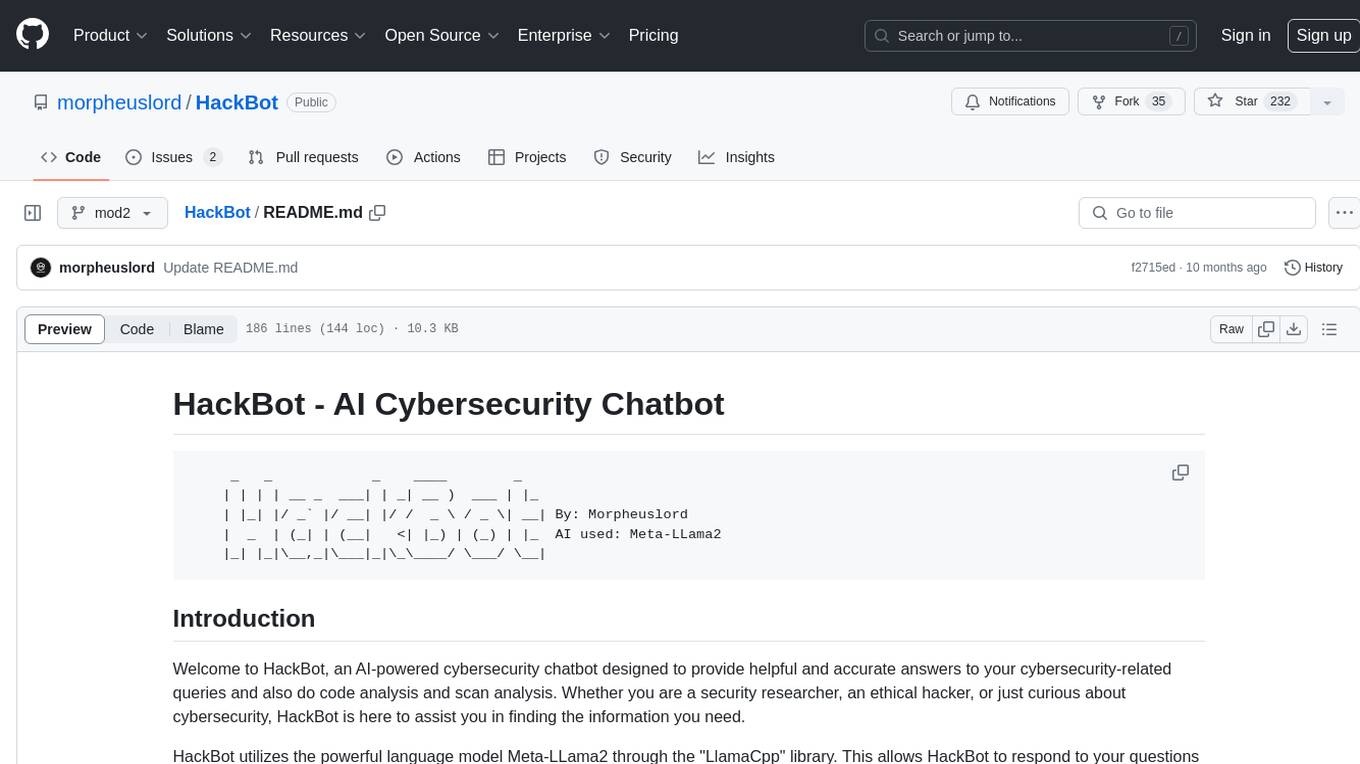
HackBot
HackBot is an AI-powered cybersecurity chatbot designed to provide accurate answers to cybersecurity-related queries, conduct code analysis, and scan analysis. It utilizes the Meta-LLama2 AI model through the 'LlamaCpp' library to respond coherently. The chatbot offers features like local AI/Runpod deployment support, cybersecurity chat assistance, interactive interface, clear output presentation, static code analysis, and vulnerability analysis. Users can interact with HackBot through a command-line interface and utilize it for various cybersecurity tasks.
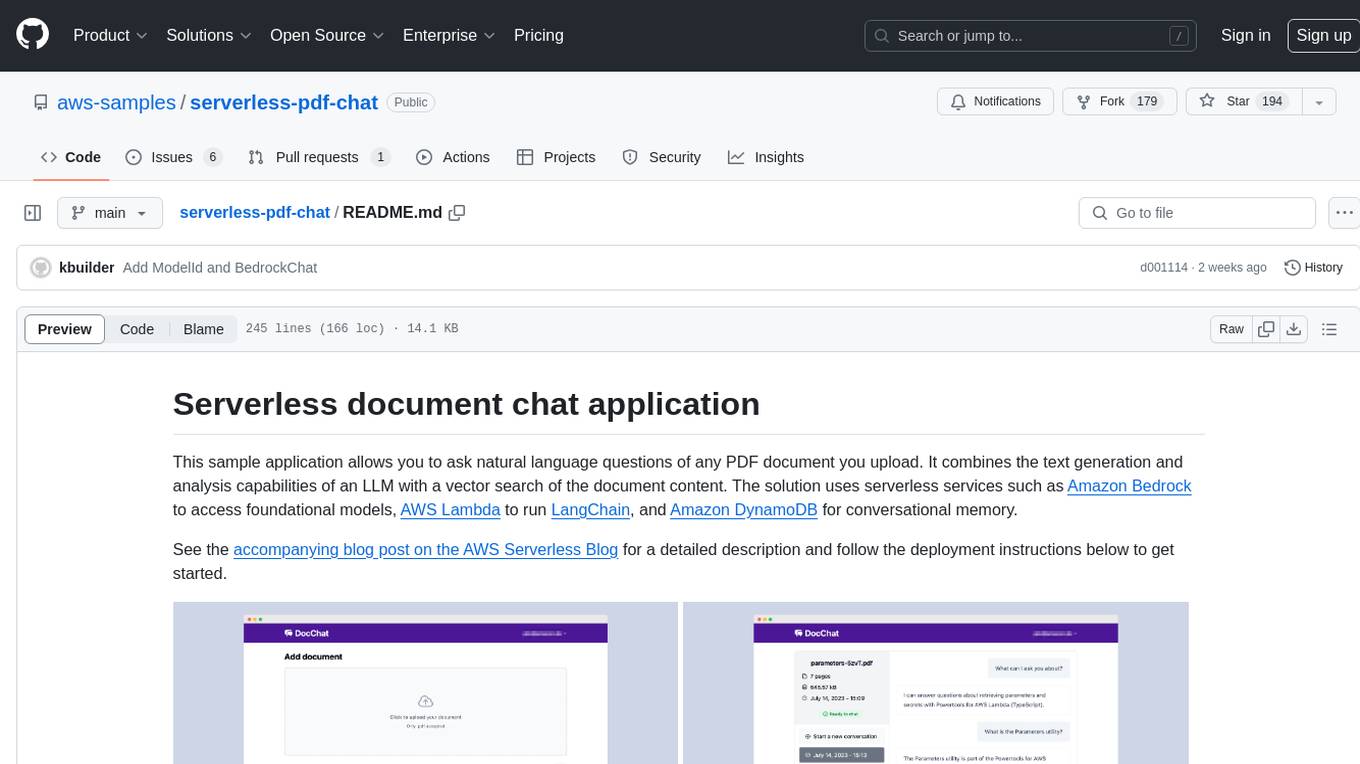
serverless-pdf-chat
The serverless-pdf-chat repository contains a sample application that allows users to ask natural language questions of any PDF document they upload. It leverages serverless services like Amazon Bedrock, AWS Lambda, and Amazon DynamoDB to provide text generation and analysis capabilities. The application architecture involves uploading a PDF document to an S3 bucket, extracting metadata, converting text to vectors, and using a LangChain to search for information related to user prompts. The application is not intended for production use and serves as a demonstration and educational tool.
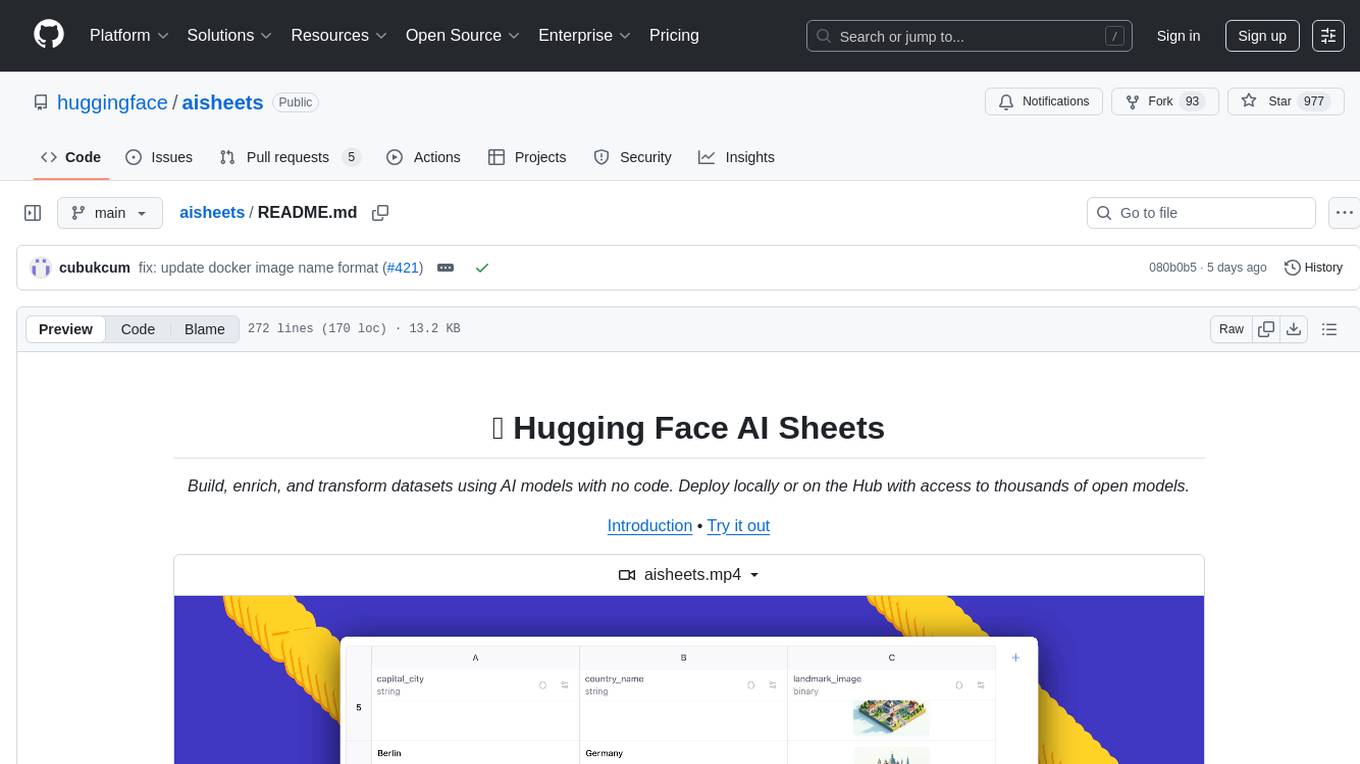
aisheets
Hugging Face AI Sheets is an open-source tool for building, enriching, and transforming datasets using AI models with no code. It can be deployed locally or on the Hub, providing access to thousands of open models. Users can easily generate datasets, run data generation scripts, and customize inference endpoints for text generation. The tool supports custom LLMs and offers advanced configuration options for authentication, inference, and miscellaneous settings. With AI Sheets, users can leverage the power of AI models without writing any code, making dataset management and transformation efficient and accessible.
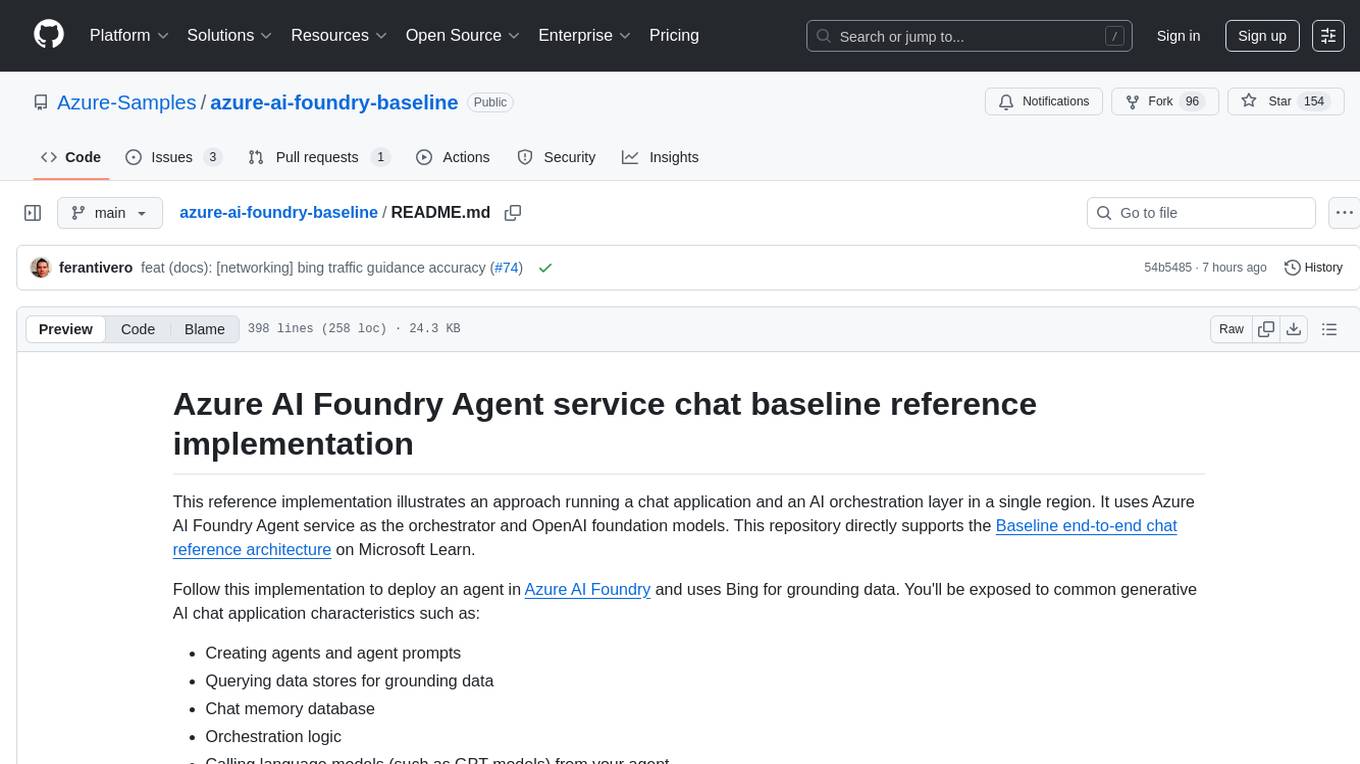
azure-ai-foundry-baseline
This repository serves as a reference implementation for running a chat application and an AI orchestration layer using Azure AI Foundry Agent service and OpenAI foundation models. It covers common generative AI chat application characteristics such as creating agents, querying data stores, chat memory database, orchestration logic, and calling language models. The implementation also includes production requirements like network isolation, Azure AI Foundry Agent Service dependencies, availability zone reliability, and limiting egress network traffic with Azure Firewall.
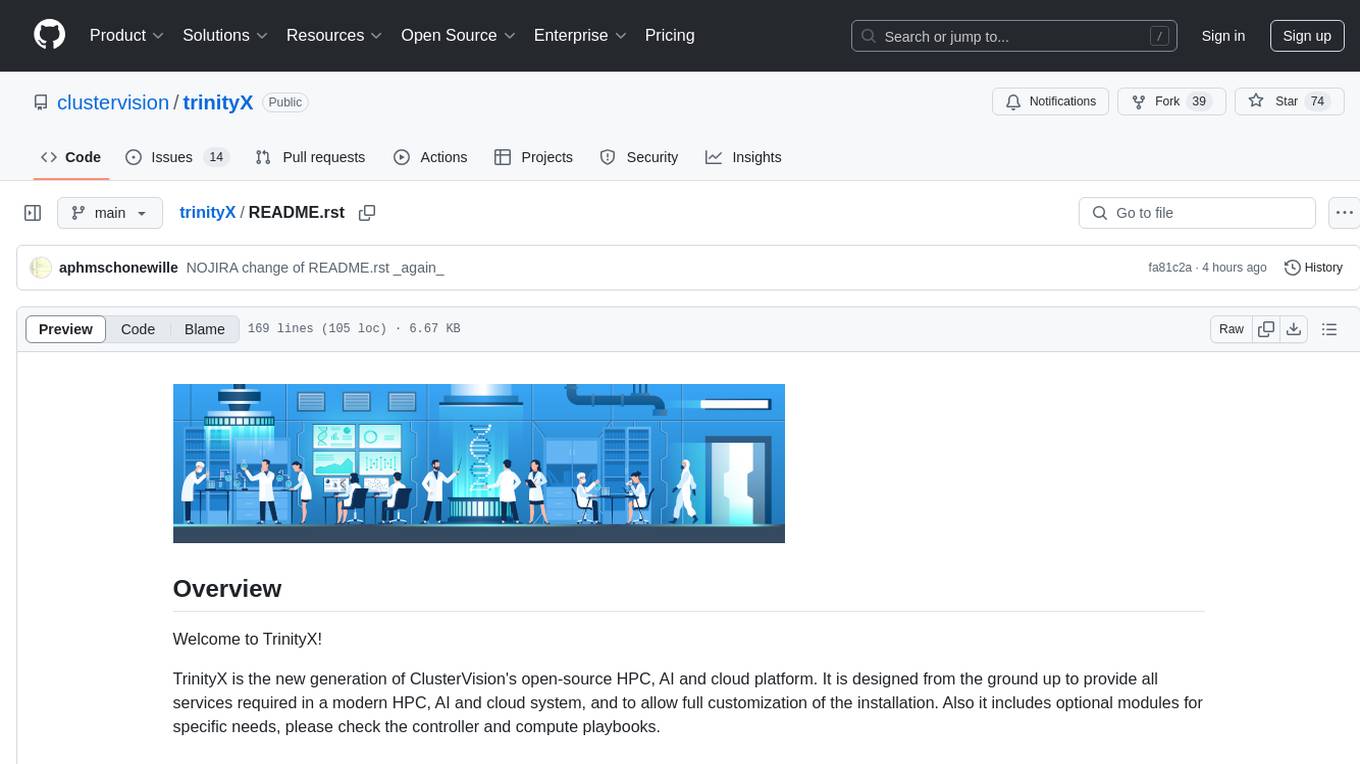
trinityX
TrinityX is an open-source HPC, AI, and cloud platform designed to provide all services required in a modern system, with full customization options. It includes default services like Luna node provisioner, OpenLDAP, SLURM or OpenPBS, Prometheus, Grafana, OpenOndemand, and more. TrinityX also sets up NFS-shared directories, OpenHPC applications, environment modules, HA, and more. Users can install TrinityX on Enterprise Linux, configure network interfaces, set up passwordless authentication, and customize the installation using Ansible playbooks. The platform supports HA, OpenHPC integration, and provides detailed documentation for users to contribute to the project.
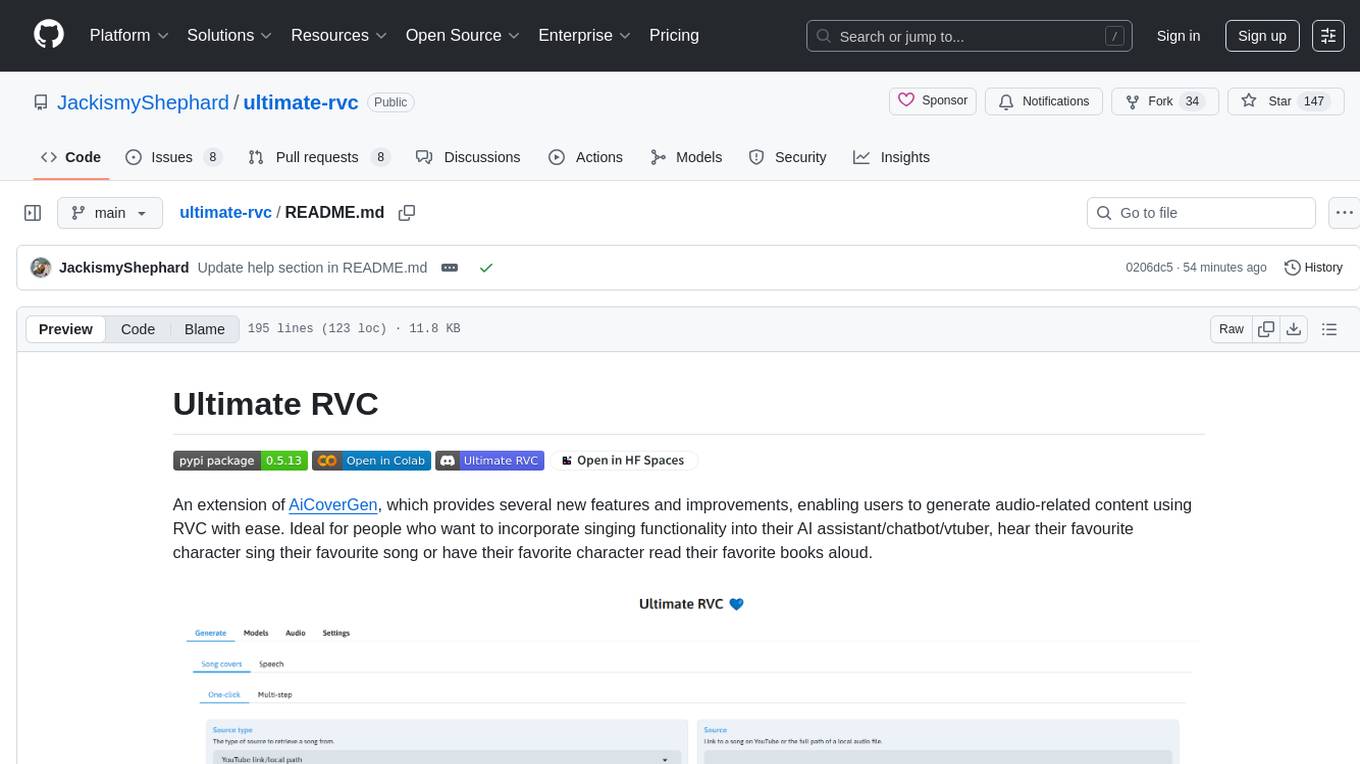
ultimate-rvc
Ultimate RVC is an extension of AiCoverGen, offering new features and improvements for generating audio content using RVC. It is designed for users looking to integrate singing functionality into AI assistants/chatbots/vtubers, create character voices for songs or books, and train voice models. The tool provides easy setup, voice conversion enhancements, TTS functionality, voice model training suite, caching system, UI improvements, and support for custom configurations. It is available for local and Google Colab use, with a PyPI package for easy access. The tool also offers CLI usage and customization through environment variables.

lumigator
Lumigator is an open-source platform developed by Mozilla.ai to help users select the most suitable language model for their specific needs. It supports the evaluation of summarization tasks using sequence-to-sequence models such as BART and BERT, as well as causal models like GPT and Mistral. The platform aims to make model selection transparent, efficient, and empowering by providing a framework for comparing LLMs using task-specific metrics to evaluate how well a model fits a project's needs. Lumigator is in the early stages of development and plans to expand support to additional machine learning tasks and use cases in the future.
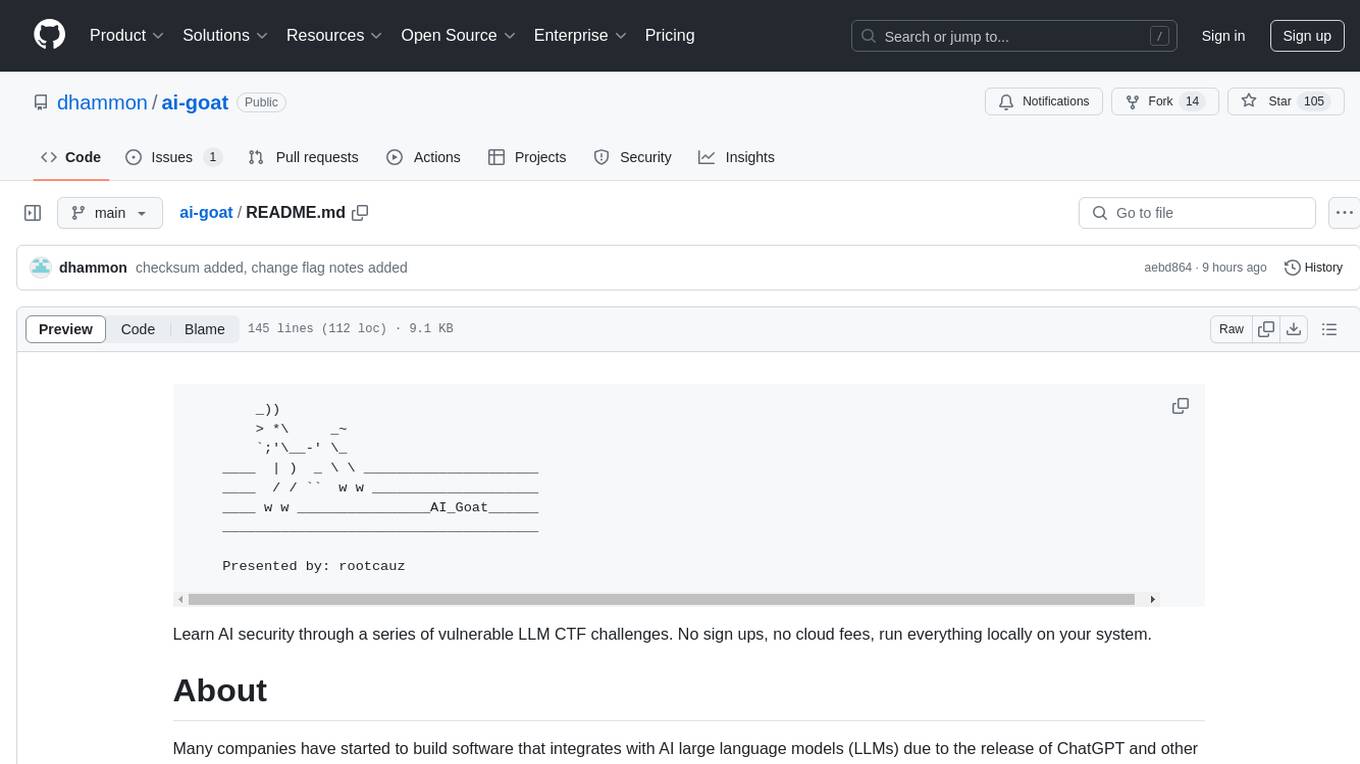
ai-goat
AI Goat is a tool designed to help users learn about AI security through a series of vulnerable LLM CTF challenges. It allows users to run everything locally on their system without the need for sign-ups or cloud fees. The tool focuses on exploring security risks associated with large language models (LLMs) like ChatGPT, providing practical experience for security researchers to understand vulnerabilities and exploitation techniques. AI Goat uses the Vicuna LLM, derived from Meta's LLaMA and ChatGPT's response data, to create challenges that involve prompt injections, insecure output handling, and other LLM security threats. The tool also includes a prebuilt Docker image, ai-base, containing all necessary libraries to run the LLM and challenges, along with an optional CTFd container for challenge management and flag submission.
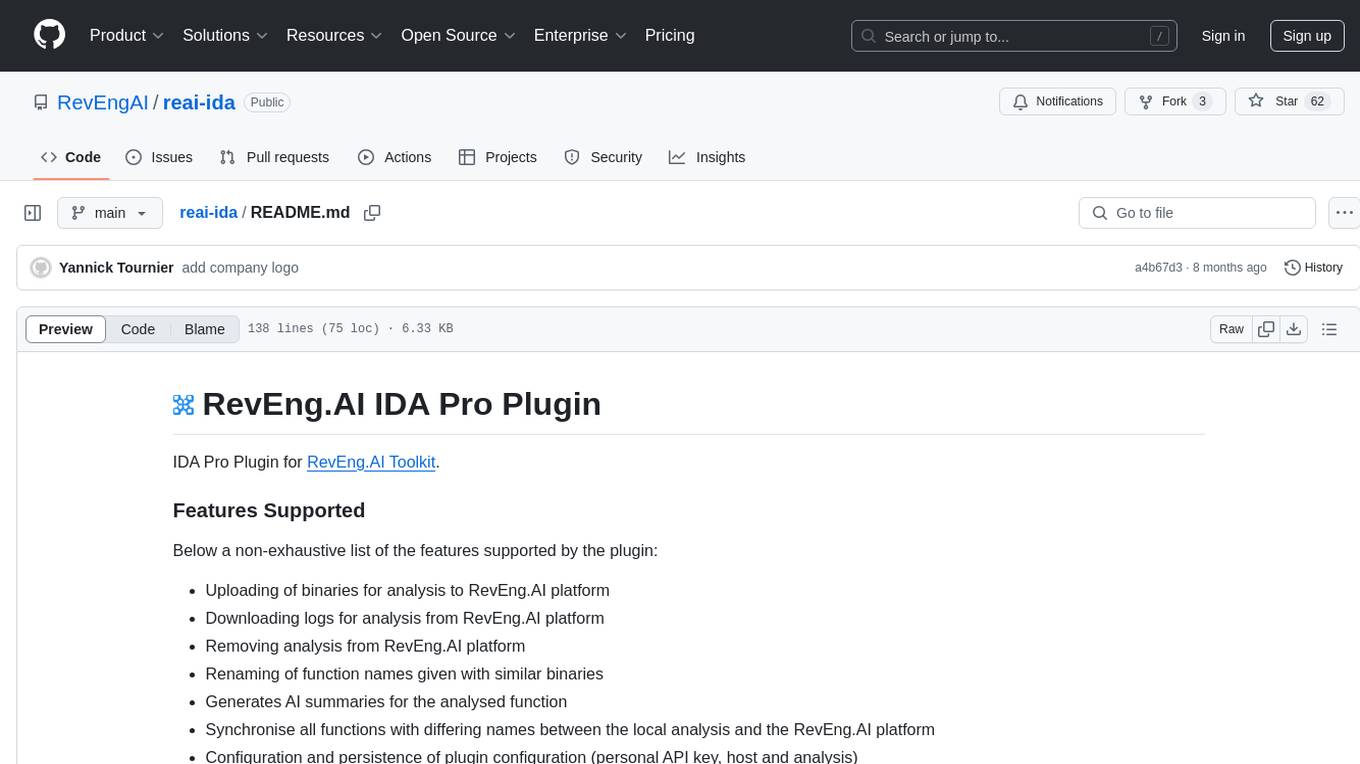
reai-ida
RevEng.AI IDA Pro Plugin is a tool that integrates with the RevEng.AI platform to provide various features such as uploading binaries for analysis, downloading analysis logs, renaming function names, generating AI summaries, synchronizing functions between local analysis and the platform, and configuring plugin settings. Users can upload files for analysis, synchronize function names, rename functions, generate block summaries, and explain function behavior using this plugin. The tool requires IDA Pro v8.0 or later with Python 3.9 and higher. It relies on the 'reait' package for functionality.
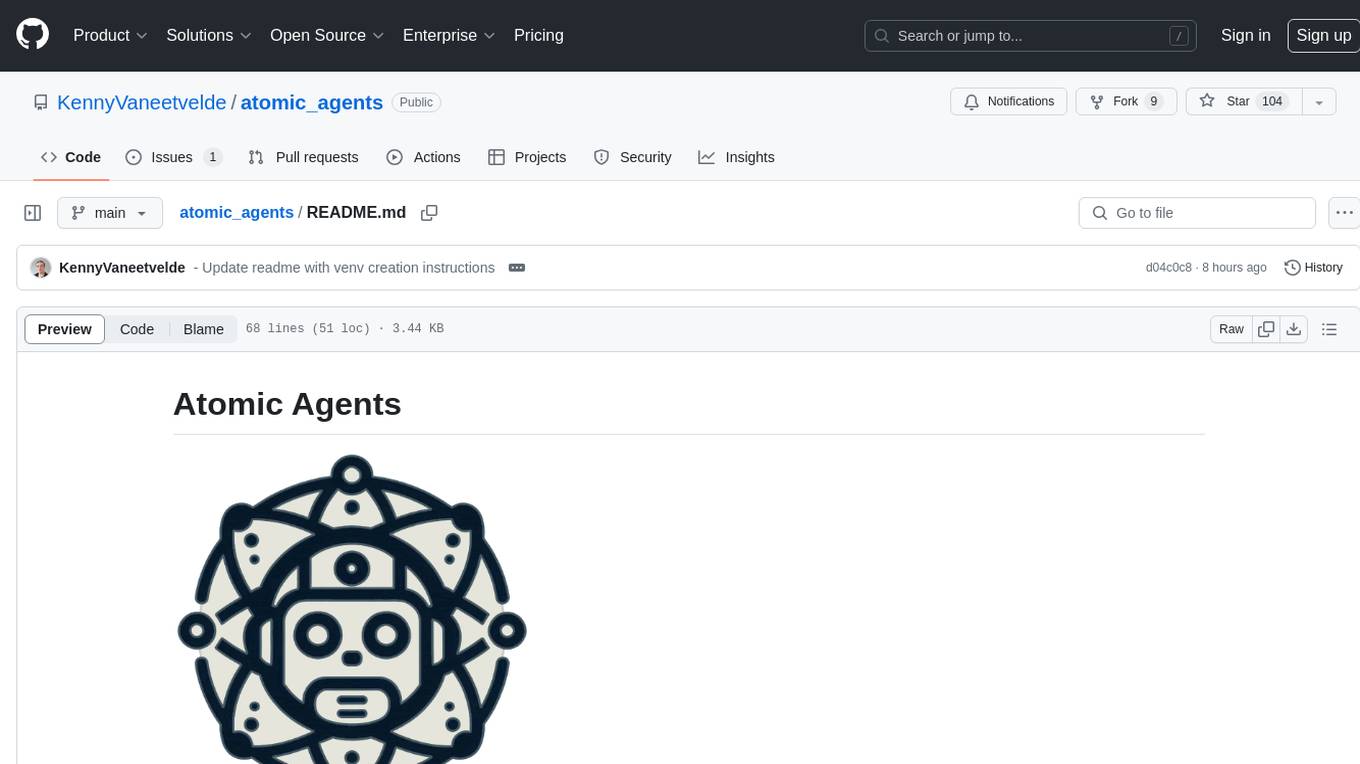
atomic_agents
Atomic Agents is a modular and extensible framework designed for creating powerful applications. It follows the principles of Atomic Design, emphasizing small and single-purpose components. Leveraging Pydantic for data validation and serialization, the framework offers a set of tools and agents that can be combined to build AI applications. It depends on the Instructor package and supports various APIs like OpenAI, Cohere, Anthropic, and Gemini. Atomic Agents is suitable for developers looking to create AI agents with a focus on modularity and flexibility.

eureka-ml-insights
The Eureka ML Insights Framework is a repository containing code designed to help researchers and practitioners run reproducible evaluations of generative models efficiently. Users can define custom pipelines for data processing, inference, and evaluation, as well as utilize pre-defined evaluation pipelines for key benchmarks. The framework provides a structured approach to conducting experiments and analyzing model performance across various tasks and modalities.
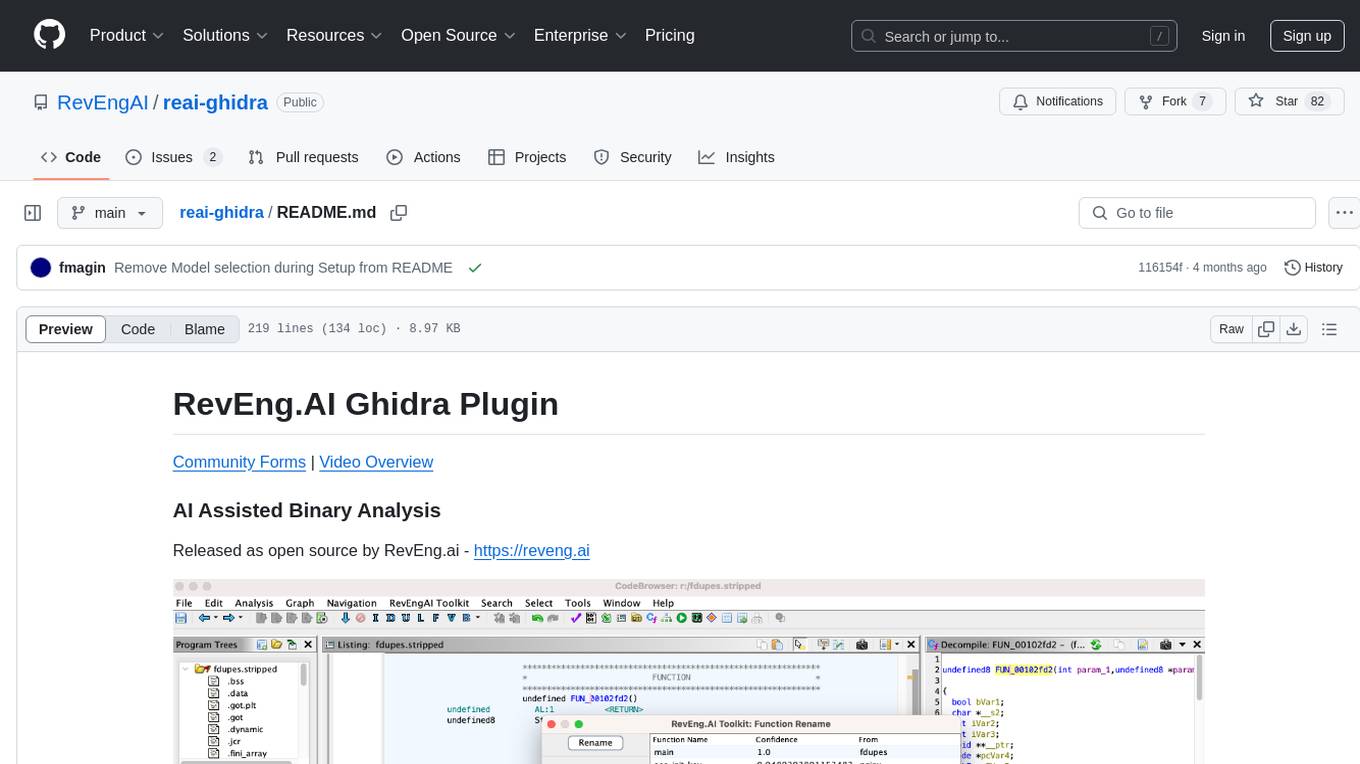
reai-ghidra
The RevEng.AI Ghidra Plugin by RevEng.ai allows users to interact with their API within Ghidra for Binary Code Similarity analysis to aid in Reverse Engineering stripped binaries. Users can upload binaries, rename functions above a confidence threshold, and view similar functions for a selected function.
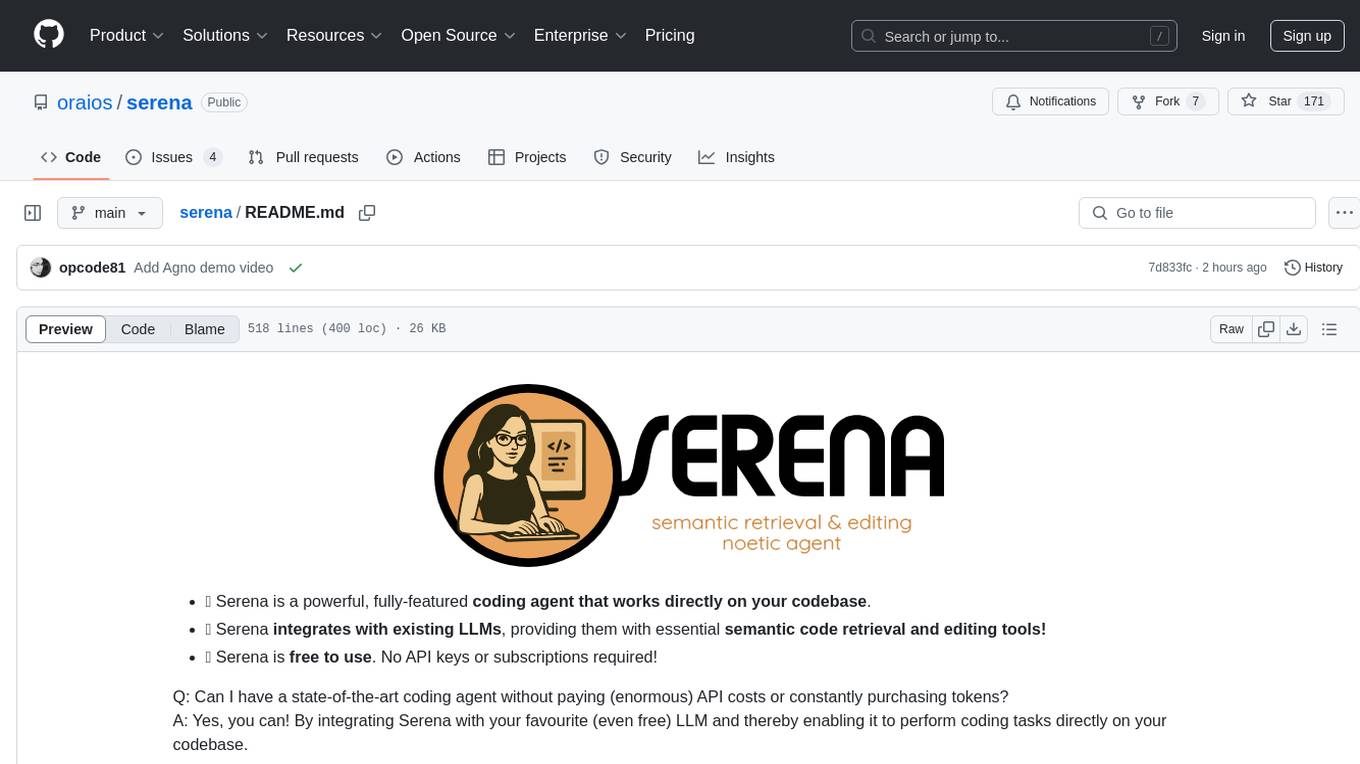
serena
Serena is a powerful coding agent that integrates with existing LLMs to provide essential semantic code retrieval and editing tools. It is free to use and does not require API keys or subscriptions. Serena can be used for coding tasks such as analyzing, planning, and editing code directly on your codebase. It supports various programming languages and offers semantic code analysis capabilities through language servers. Serena can be integrated with different LLMs using the model context protocol (MCP) or Agno framework. The tool provides a range of functionalities for code retrieval, editing, and execution, making it a versatile coding assistant for developers.
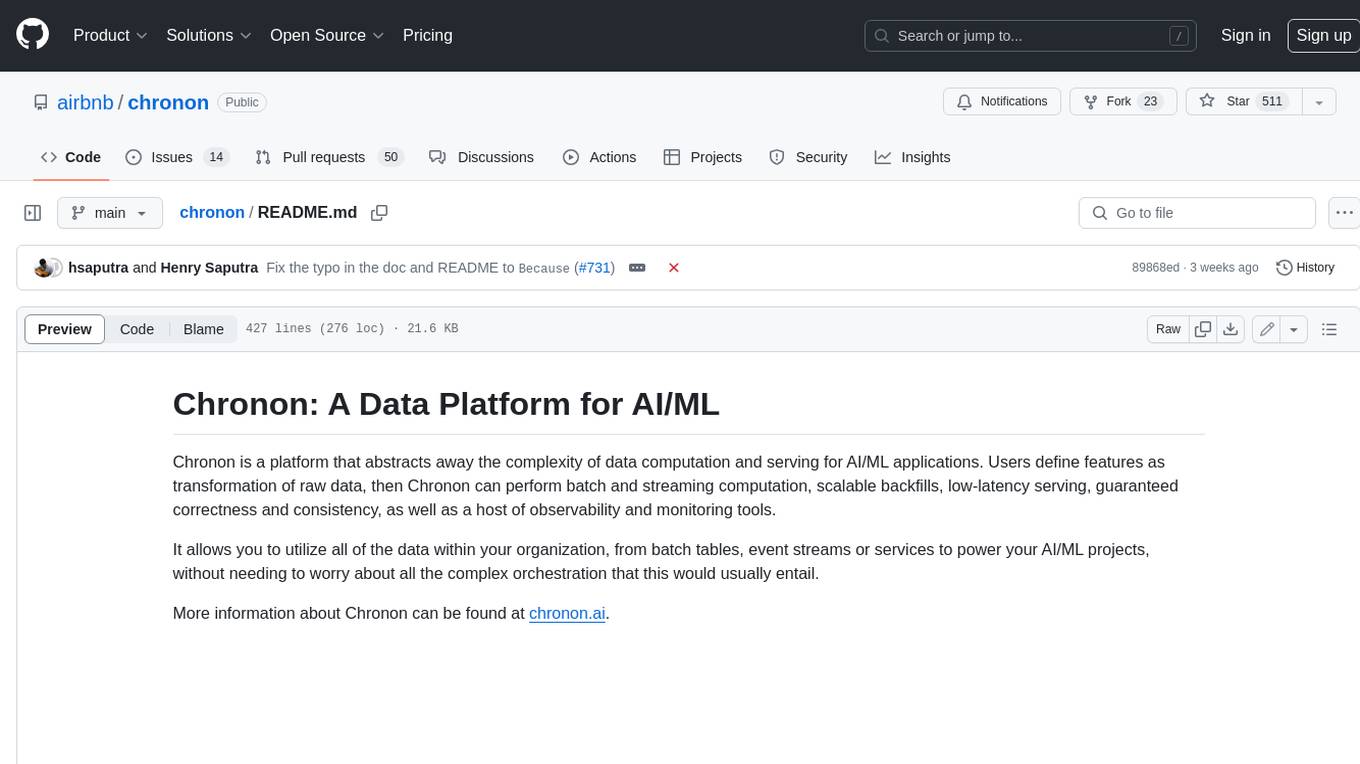
chronon
Chronon is a platform that simplifies and improves ML workflows by providing a central place to define features, ensuring point-in-time correctness for backfills, simplifying orchestration for batch and streaming pipelines, offering easy endpoints for feature fetching, and guaranteeing and measuring consistency. It offers benefits over other approaches by enabling the use of a broad set of data for training, handling large aggregations and other computationally intensive transformations, and abstracting away the infrastructure complexity of data plumbing.
For similar tasks

cluster-toolkit
Cluster Toolkit is an open-source software by Google Cloud for deploying AI/ML and HPC environments on Google Cloud. It allows easy deployment following best practices, with high customization and extensibility. The toolkit includes tutorials, examples, and documentation for various modules designed for AI/ML and HPC use cases.
For similar jobs

AirGo
AirGo is a front and rear end separation, multi user, multi protocol proxy service management system, simple and easy to use. It supports vless, vmess, shadowsocks, and hysteria2.
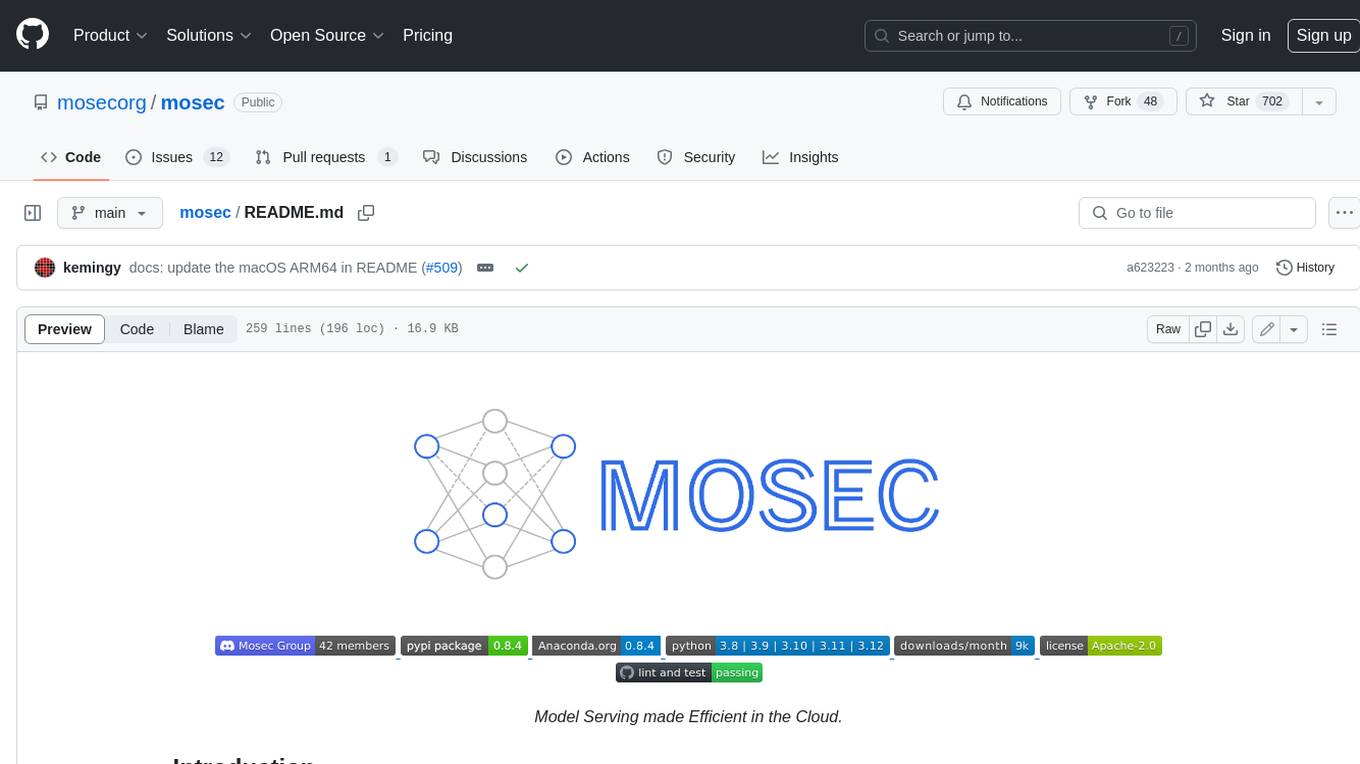
mosec
Mosec is a high-performance and flexible model serving framework for building ML model-enabled backend and microservices. It bridges the gap between any machine learning models you just trained and the efficient online service API. * **Highly performant** : web layer and task coordination built with Rust 🦀, which offers blazing speed in addition to efficient CPU utilization powered by async I/O * **Ease of use** : user interface purely in Python 🐍, by which users can serve their models in an ML framework-agnostic manner using the same code as they do for offline testing * **Dynamic batching** : aggregate requests from different users for batched inference and distribute results back * **Pipelined stages** : spawn multiple processes for pipelined stages to handle CPU/GPU/IO mixed workloads * **Cloud friendly** : designed to run in the cloud, with the model warmup, graceful shutdown, and Prometheus monitoring metrics, easily managed by Kubernetes or any container orchestration systems * **Do one thing well** : focus on the online serving part, users can pay attention to the model optimization and business logic
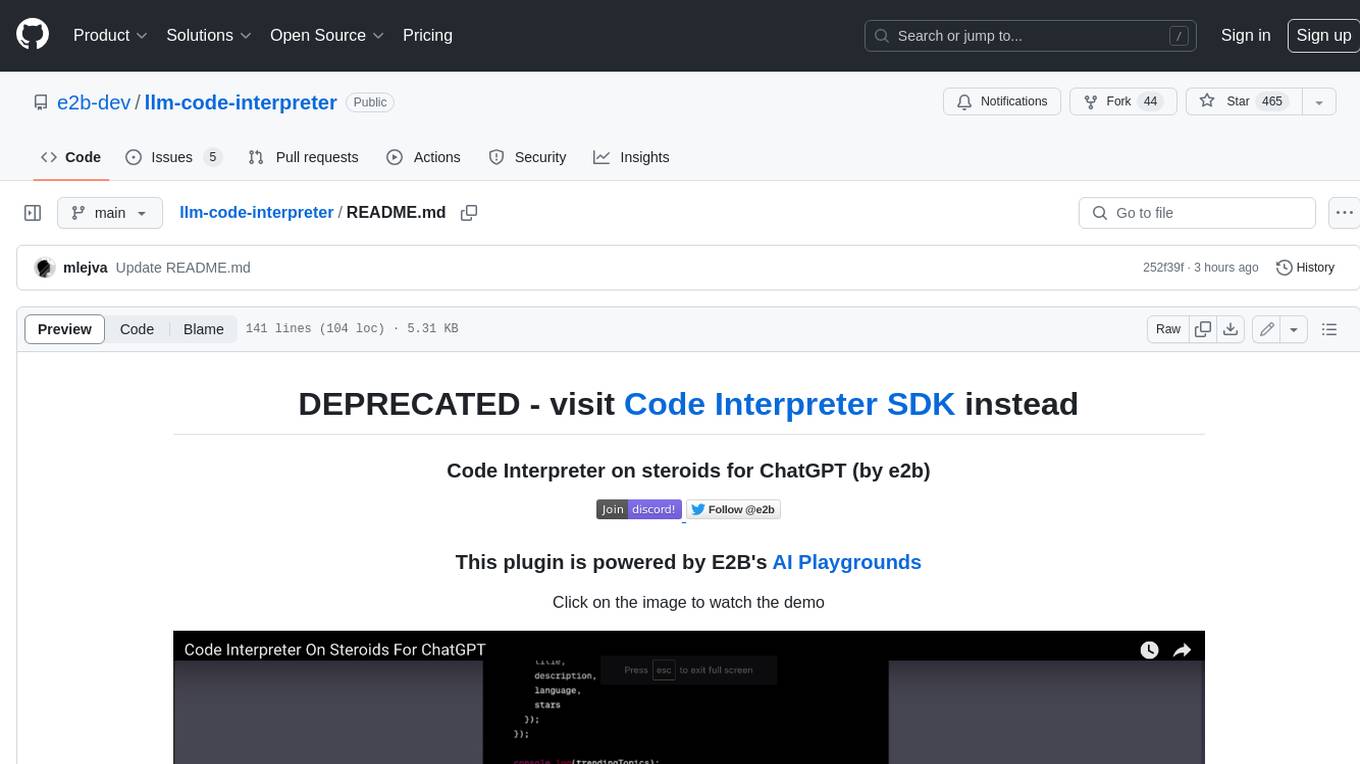
llm-code-interpreter
The 'llm-code-interpreter' repository is a deprecated plugin that provides a code interpreter on steroids for ChatGPT by E2B. It gives ChatGPT access to a sandboxed cloud environment with capabilities like running any code, accessing Linux OS, installing programs, using filesystem, running processes, and accessing the internet. The plugin exposes commands to run shell commands, read files, and write files, enabling various possibilities such as running different languages, installing programs, starting servers, deploying websites, and more. It is powered by the E2B API and is designed for agents to freely experiment within a sandboxed environment.

pezzo
Pezzo is a fully cloud-native and open-source LLMOps platform that allows users to observe and monitor AI operations, troubleshoot issues, save costs and latency, collaborate, manage prompts, and deliver AI changes instantly. It supports various clients for prompt management, observability, and caching. Users can run the full Pezzo stack locally using Docker Compose, with prerequisites including Node.js 18+, Docker, and a GraphQL Language Feature Support VSCode Extension. Contributions are welcome, and the source code is available under the Apache 2.0 License.
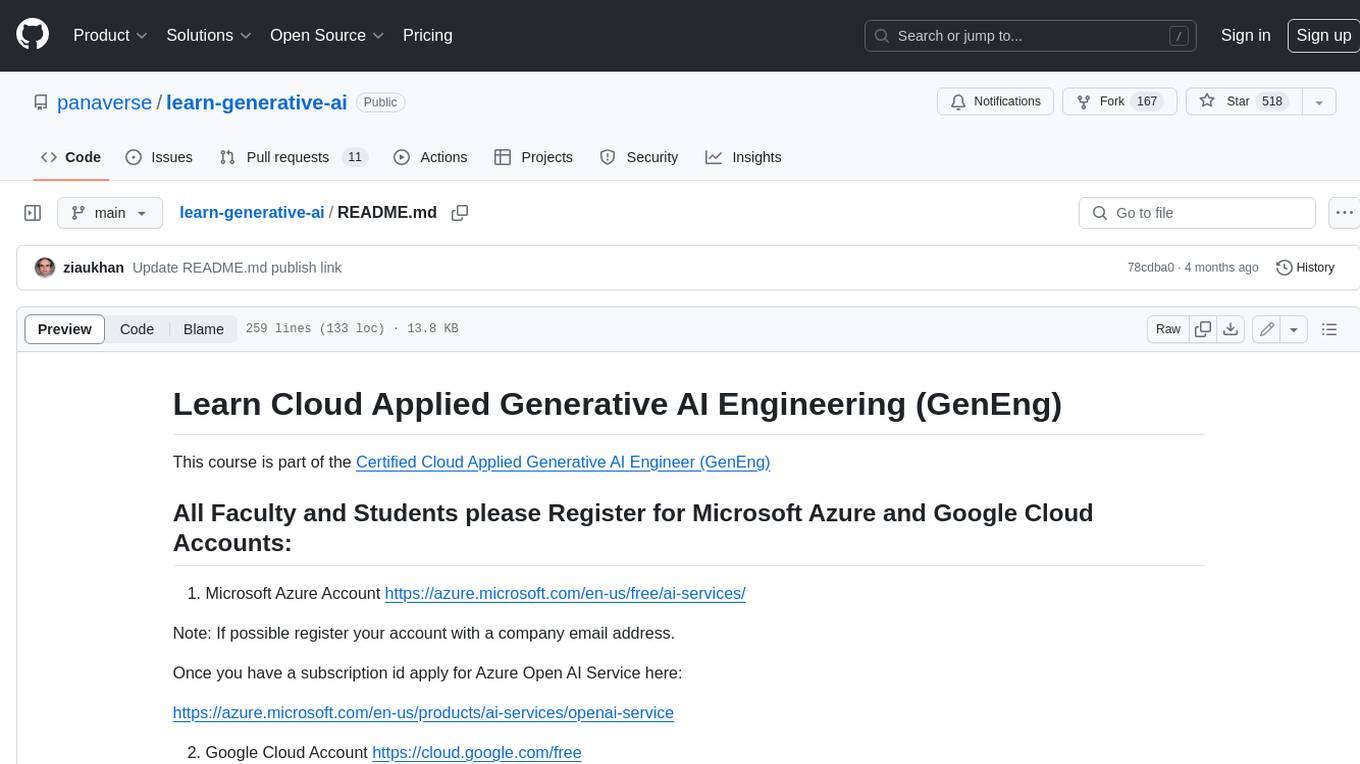
learn-generative-ai
Learn Cloud Applied Generative AI Engineering (GenEng) is a course focusing on the application of generative AI technologies in various industries. The course covers topics such as the economic impact of generative AI, the role of developers in adopting and integrating generative AI technologies, and the future trends in generative AI. Students will learn about tools like OpenAI API, LangChain, and Pinecone, and how to build and deploy Large Language Models (LLMs) for different applications. The course also explores the convergence of generative AI with Web 3.0 and its potential implications for decentralized intelligence.
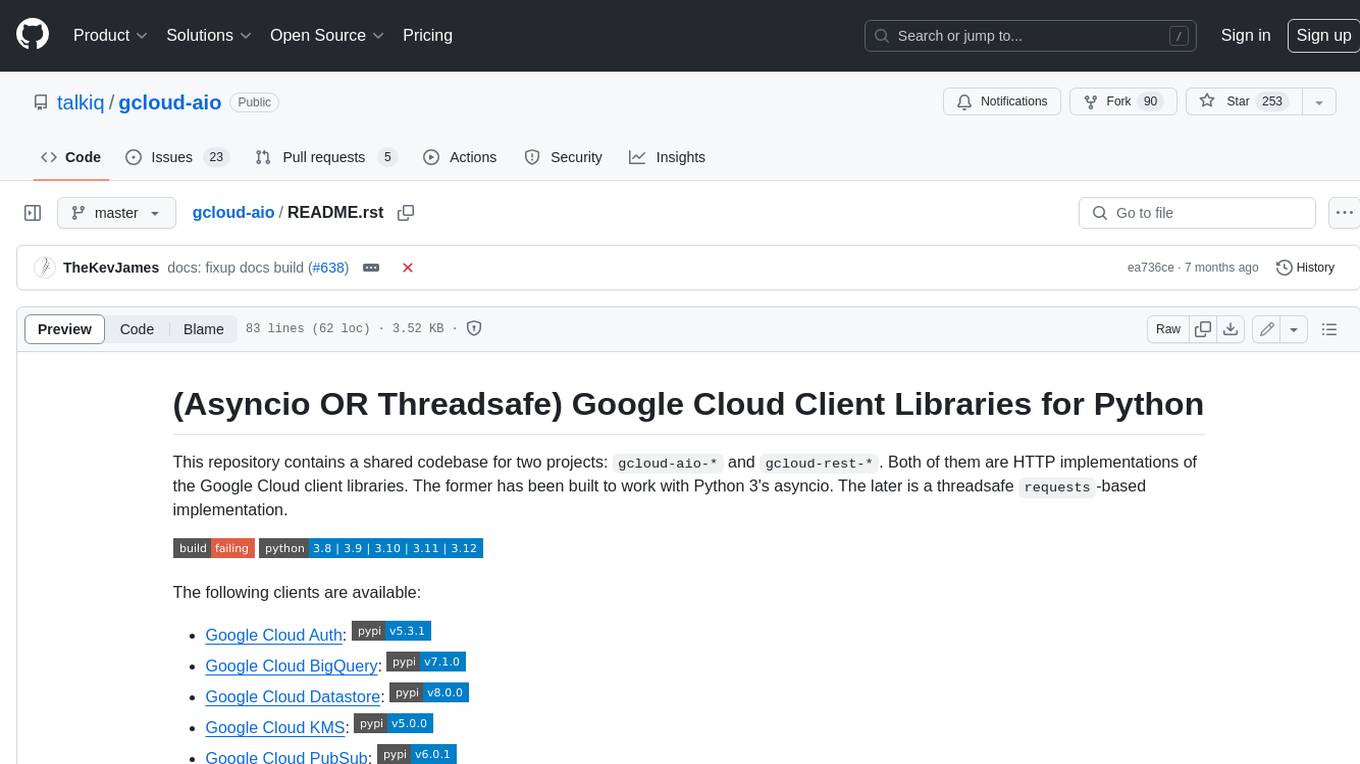
gcloud-aio
This repository contains shared codebase for two projects: gcloud-aio and gcloud-rest. gcloud-aio is built for Python 3's asyncio, while gcloud-rest is a threadsafe requests-based implementation. It provides clients for Google Cloud services like Auth, BigQuery, Datastore, KMS, PubSub, Storage, and Task Queue. Users can install the library using pip and refer to the documentation for usage details. Developers can contribute to the project by following the contribution guide.
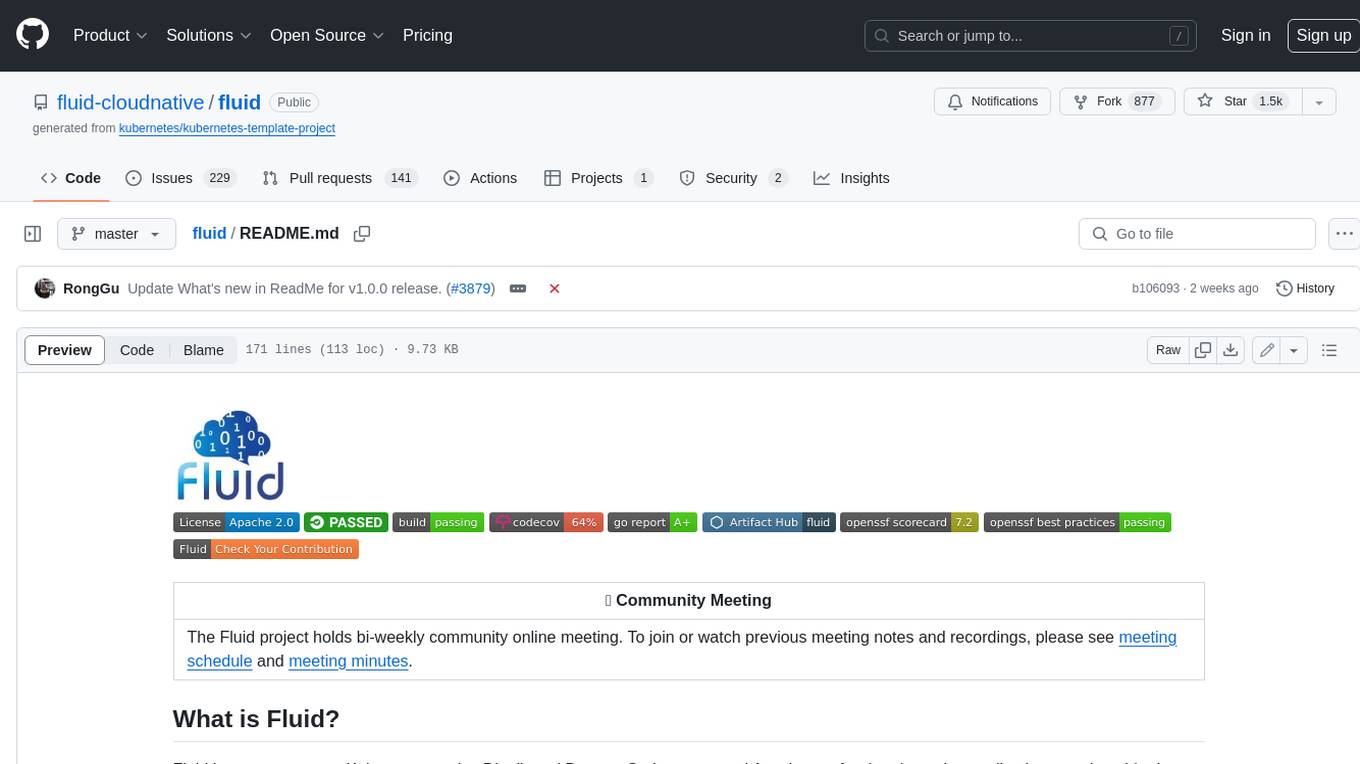
fluid
Fluid is an open source Kubernetes-native Distributed Dataset Orchestrator and Accelerator for data-intensive applications, such as big data and AI applications. It implements dataset abstraction, scalable cache runtime, automated data operations, elasticity and scheduling, and is runtime platform agnostic. Key concepts include Dataset and Runtime. Prerequisites include Kubernetes version > 1.16, Golang 1.18+, and Helm 3. The tool offers features like accelerating remote file accessing, machine learning, accelerating PVC, preloading dataset, and on-the-fly dataset cache scaling. Contributions are welcomed, and the project is under the Apache 2.0 license with a vendor-neutral approach.
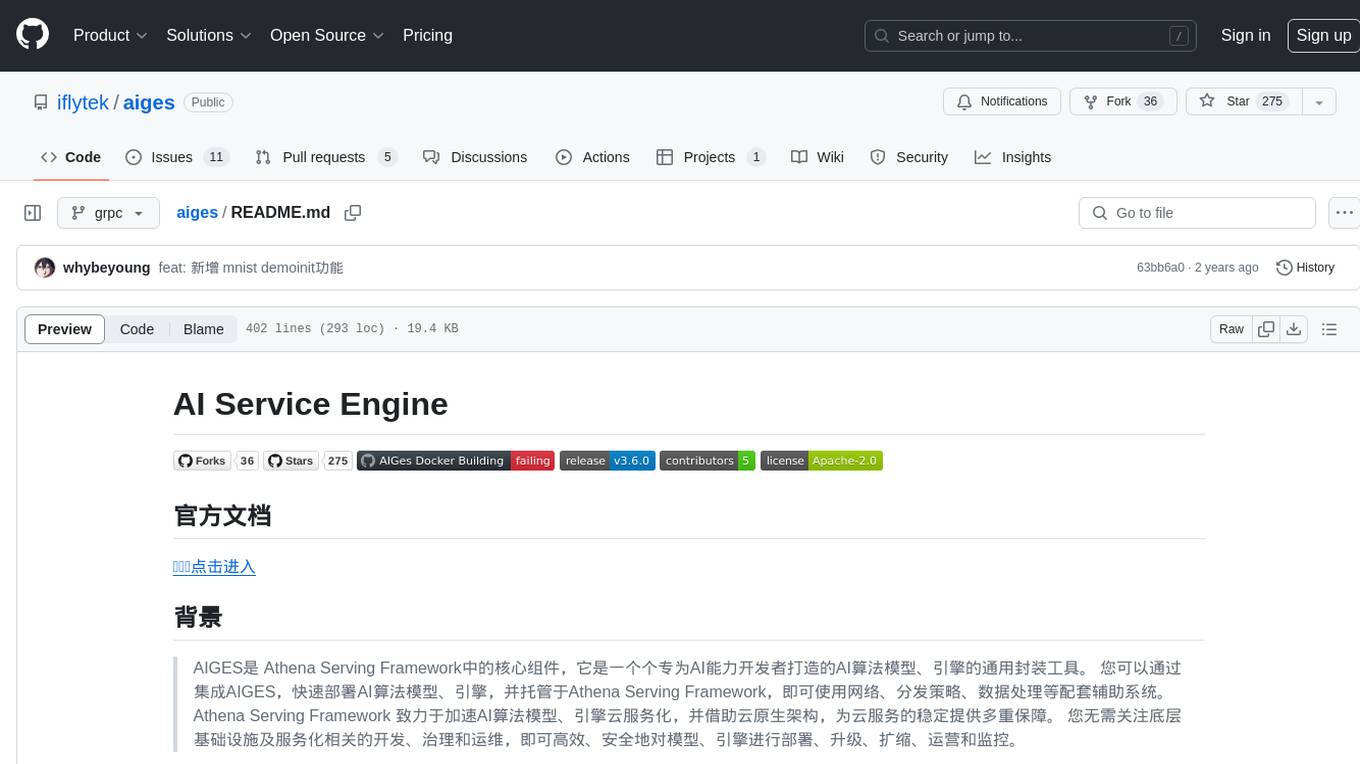
aiges
AIGES is a core component of the Athena Serving Framework, designed as a universal encapsulation tool for AI developers to deploy AI algorithm models and engines quickly. By integrating AIGES, you can deploy AI algorithm models and engines rapidly and host them on the Athena Serving Framework, utilizing supporting auxiliary systems for networking, distribution strategies, data processing, etc. The Athena Serving Framework aims to accelerate the cloud service of AI algorithm models and engines, providing multiple guarantees for cloud service stability through cloud-native architecture. You can efficiently and securely deploy, upgrade, scale, operate, and monitor models and engines without focusing on underlying infrastructure and service-related development, governance, and operations.